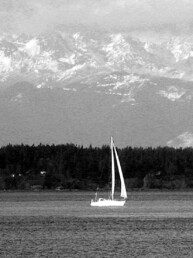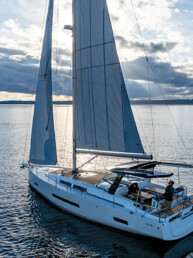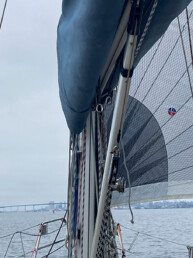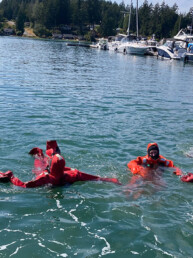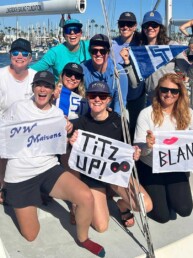Around the Pacific Northwest, heroes come in many forms, and 48° North is excited to honor some of them in this series. Here is part one of an interview with Dick Rose, a man many think of as “The Rules Guy” but whose accomplishments and contributions to sailing are truly extraordinary and wide reaching.
From the March 2021 issue of 48° North.
Can you tell us about how you got started in sailing?
My dad was a powerboat guy and into fishing. We spent summers in a small house on Peconic Bay, on the non-posh northern fork of eastern Long Island. My mother had learned to sail at a camp, though she hadn’t sailed for years. Dad built me a Chris Craft pram, which had a sailing rig; since he was into powerboats he respected the Chris Craft name. My mother tried to teach me to sail, and she couldn’t make the boat go to windward. In hindsight, it was a terrible design. She discovered that there was a junior program just a bike ride away at the Southold Yacht Club. The volunteer junior instructor was Frank Robinson, a retired guy who had won the Star World Championship in the 1920s. The junior boat was one you’ve almost surely never heard of: the Lawley 15. From a distance, you’d say, “Ah, that’s a Snipe.” There were five of them, and my parents bought me one. I can remember the first race, I was last by half a mile. But I was learning to sail and thought, ‘This is neat. If I could do this better, I could be in this game.’ So, I applied myself. I did that for three or four summers, got much better and even won a couple of trophies.
I grew up in Port Washington, New York, on Long Island Sound. It was a sailing hub, with three yacht clubs on Manhasset Bay. Our house was just two blocks from the Port Washington Yacht Club. I got a Lightning and raced in the fleet there. I got really hooked on the sport — started taking notes, reading books, and taking it very seriously. After I started college at Princeton, I got a Penguin dinghy and started to frostbite in the winter, and that’s where I really met good competition. The founder of the Princeton University Yacht Club was Arthur Knapp, the America’s Cup skipper. He was one of the best sailors in the highly competitive Larchmont Yacht Club frostbite fleet.
Arthur bought a dinghy exactly like his own, named her Tiger and painted her in Princeton orange and black. He made it available to undergraduates at Princeton. For a day of racing at Larchmont we had to drive from Princeton through New York City to Larchmont on a Sunday, we’d race in the afternoon for two or three hours, and then drive home. Not many undergraduates wanted to do that, but I thought this was a fabulous opportunity and so did a friend, Gordon Jennings. We drove an old Chevrolet, sliding our way through snowstorms and traffic to Larchmont.
Arthur would coach us between races… sort of. His coaching consisted of coming by and saying, “You damn fools, you started at the wrong end of the line. You’re sitting too far aft. Bunch your weight and tighten your outhaul!” If we did all those things, we beat more boats in the next race. We started to move up in the fleet.
How did you find your way to Seattle?
I got a math degree from Princeton, and a PhD in Mathematical Psychology from the University of Pennsylvania, where I studied probabilistic models for perception and learning. Afterward, I sought a position as professor and the University of Washington offered me a job. I moved to Seattle in 1966, and I’ve been here ever since.
Seattle is a great sailing town, I was delighted to be coming here. One of the huge advantages were the protected waters and the cruising grounds. When I got to Seattle, there was a Penguin fleet, but it was on its very last legs. The most competitive fleet at that time was the International 14 dinghy. I raced in that fleet for 20 years.
During that time, the Laser came on the scene. It was being built by Ian Bruce in Quebec, and Ian was a top I-14 sailor and builder as well. I bought two I-14s from him. Ian wrote me saying, “Be my dealer for the Laser in Seattle.” I thought, ‘I’m a professor, how am I going to do this?’ I went to Annapolis for a 14 regatta and everybody was talking about the Laser. One of the 14 sailors was the Annapolis Laser dealer. He had several boats and he let us try them. The wind was light and I kicked the drain plug out and thought, ‘maybe this is a great boat but the wind is so light, I can’t really tell.’ They kept telling me, “You’ll love it. There’ll be a million of them in Seattle.” So I bought one from this Annapolis dealer and we tied it on our multi-boat trailer where we had three Seattle I-14s.
I took the boat down to the student sailing club at UW and said, “Please sail this Laser. You can use it as much as you’d like, but treat it nicely, sail it in all conditions, and I want you to tell me what it’s like.” A few days later I got this call, “We love this thing. We want to buy a fleet.” All of a sudden, I was selling Lasers as a part-time business. I then got married, and my wife Carolle was a big help — we sold 1,500 Lasers over the next 15 years or so.
We built the Seattle Laser fleet at a time that was just perfect for that boat to come out. There were many young sailors from sailing families, including the McKee brothers, Jon and Charlie, Carl Buchan; Craig Thomas, who you may not have heard of but was right up there with the McKees and Carl; and Craig’s younger brother Burke who will come up in my story later on. Burke also crewed for me on the I-14. We built up the Laser fleet sailing out of the university near the old boathouse. At our peak, we were getting 40 to 50 Lasers out racing. We worked with people in Vancouver and Victoria and developed a winter frostbite circuit. We would get 50 to 60 boats in Victoria, Vancouver, and one year on Vashon Island — and those were superb, competitive fleets. People would come from outside the Northwest to our annual Frigid Digit Regattas because they knew they’d be racing against Carl Buchan and Jonathan and Charlie McKee and others in that ‘league’.
Frostbiting has been central in your sailing life. So many people seem to think that warm weather and comfort is what will enthuse sailors. Why do you think frostbiting works?
What I grew up with on Long Island Sound — it’s still there and it’s still great — is winter frostbiting for a few hours every weekend in a small dinghy. What made it particularly interesting to me is that the people who were most interested in the sport in the summer were the ones who wanted to continue it in the winter. If I raced with that fleet, I got superb competition. If you’re looking to improve, you want to sail against the best. I was just soaking up knowledge sailing in those winter dinghy races.
I wanted to try to recreate that sort of program here in Seattle with weekly local races and monthly ‘circuit’ regattas, and this plan succeeded for several years, with youth and adults racing together in one fleet. Frostbiting is an opportunity for the people who are particularly enthusiastic about the sport to come together when nothing else is going on with other boats. Get a fairly inexpensive dinghy and race a lot of short races; you’re not far from shore and modern clothing is such that you can do it and be comfortable.
Our program in Seattle wasn’t just frostbiting, it was the same program year ‘round. Most of the year we raced on Sundays, but during daylight savings we sailed on Monday nights. I remember once when Christmas fell on a Sunday. I was chatting with the fleet on the dock and I said, “With Christmas being on a Sunday, I suppose we don’t race that day.” And Charlie McKee said, “Hell no! You don’t have to race, but don’t call it off.” It was a fleet for enthusiasts – you might call it diehards yacht club. The sailors realized the value of the program. If you wanted to learn and get better, you could find the best sailors in the area if you raced in that program.
You’re known as one of the most influential people in the world of racing rules. How did that happen?
One of my contacts from my sailing on Long Island was Ellen Bentsen. Her husband was Bill Bentsen, a leading expert on the racing rules. Bill won two Olympic medals crewing for Buddy Melges. Ellen was an editor at Yachting magazine. When she had some difficulty with an article that she thought was interesting, she’d send it to me and say, “Do you understand this? I think it’s a little complicated for our readers. Maybe you could clean it up a little bit and we could publish it?” The first was an article about sailing in current, and it had some interesting ideas, so I did that.
Yachting decided to have columnists on one-design small boat racing, and engaged me as one of them. This overlapped with the years when the Laser was coming on strong. The Laser was so light compared to other boats that it really responded to kinetics. When the Laser became popular, the rule governing kinetics was inadequate. For a while, Laser sailing turned into a rock-a-thon where the more you rocked your boat the faster you went, the more you pumped your sail the faster you went. If you rocked and pumped, your chances of winning went way up, and few competitors were willing to protest.
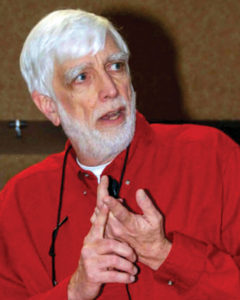 I wrote about the kinetics problem and had some ideas on how to control it. One of my magazine articles caught the attention of people at what is now World Sailing, in those days it was called the International Yacht Racing Union (IYRU). On the basis of my article, they invited me to come to London for their annual meeting to speak to them about ways the sport could approach kinetics and make it so the game was fun and not just breathless, frantic, thrashing about in the boat. I gave my talk and ended up being appointed to a committee that consisted of Dave Perry, who is still heavily involved in the rules, a very bright guy named Andy Kostanecki, a Finn sailor who was then the team leader for the U.S. Olympic team, and me. The three of us wrote a rule which is very similar to the propulsion rule (Rule 42) in the rulebook today. A short time later, I was nominated by US Sailing to join the International Rules Committee, and I’ve been a member ever since.
I wrote about the kinetics problem and had some ideas on how to control it. One of my magazine articles caught the attention of people at what is now World Sailing, in those days it was called the International Yacht Racing Union (IYRU). On the basis of my article, they invited me to come to London for their annual meeting to speak to them about ways the sport could approach kinetics and make it so the game was fun and not just breathless, frantic, thrashing about in the boat. I gave my talk and ended up being appointed to a committee that consisted of Dave Perry, who is still heavily involved in the rules, a very bright guy named Andy Kostanecki, a Finn sailor who was then the team leader for the U.S. Olympic team, and me. The three of us wrote a rule which is very similar to the propulsion rule (Rule 42) in the rulebook today. A short time later, I was nominated by US Sailing to join the International Rules Committee, and I’ve been a member ever since.
At the end of one meeting in the early 90s, a world class Star sailor representing Brazil got up and said, “Guys, you keep adding rules, it’s getting more complicated. Couldn’t the rules be simpler?” I’m paraphrasing, but he came on pretty hard. The chairman was sort of taken aback, and said, “Thank you. We will take that under advisement and come back next year with a report.” So, the challenge was out. Could the IYRU rewrite the rulebook in a simpler way?
A core group of five of us on the IYRU Racing Rules Commmittee were appointed to work on this rule simplification project. In the first year, our chairman Mary Parra from England published a notice encouraging countries in the IYRU to make suggestions on how we could make the rules simpler. We got quite a few letters, and they contained some rather bizarre things — adapting car racing rules or reducing competition by making a game where you throw a sponge between boats like tag or water polo. At a meeting of the U.S. Rules Committee in Chicago the next year, Bill Bentsen and I presented the ideas that had come in. It was obvious that they would make major changes in the game. There was a deathly silence in the room. Committee member David Dellenbaugh — who you probably know from his Speed and Smarts newsletter and as an America’s Cup skipper — said, “You know, I kind of like sailing the way it is. Couldn’t we just try to simplify the rules without changing the game?”
There was a club on the Chesapeake that wrote us saying that the rules were so complicated, so important for the racing, and there were so many protests that, “Our club has given up racing; we’re now a cruising club — but I’d love to see racing come back if you guys could do something to simplify the rules.” He complained about a rule that said: If you were on a broad reach and someone was trying to pass you to windward, he was doing so at his own risk. You could luff him rapidly and with no warning, and if your boat collided with his boat, he had to retire from the race. “Unlimited luffing,” it was called. That rule permitted collisions, almost encouraged them. So, we eliminated that rule. Yet, this wasn’t the only situation where a boat might make contact to prove they had right-of-way.
The U.S. Rules Committee wrote a new set of right-of-way rules. We put in as a basic rule, which is now Rule 14: If reasonably possible, a boat shall avoid contact with another boat. We thought of another very fundamental rule that is still in the book. It says, in essence — there is no checkmate in sailing. Today, that’s Rule 16.1, and it reads, “When a right-of-way boat changes course, she shall give the other boat room to keep clear.” The primary goal was to give sailors a game like they’d been playing, but to cut down on damage, and to cut down on exceptions and complications. We thought it would be more fun and more welcoming to newcomers.
We took those “experimental rules” (as we called them) to the World Sailing meeting in Toronto the next year. There was to be a session at that meeting where all the countries that had produced experimental rules would bring them and present them to the World Sailing members present. We got to Toronto and, to our surprise, found we were the only country that had prepared a set of experimental rules. I was the chairman of the U.S. Rules Committee at that time, and I got up and gave a talk about our rules and what we’d tried to accomplish. At the end, we got a standing ovation.
World Sailing asked its Rules Committee to revise the entire rulebook, incorporating those U.S. ideas, but also any other ideas for simplifying any part of the rule book. That’s when I said, “I want to work on this, but I can’t do that and be on the faculty at UW.” There were a lot of meetings in England, and it just didn’t compute. So, I retired from teaching in my 50s. And I’ve been working on rules for US Sailing and World Sailing ever since.
Check back next month for Part Two, with more of Dick’s story and his immense contributions to sailing on the local and world levels .
Joe Cline
Joe Cline has been the Managing Editor of 48° North since 2014. From his career to his volunteer leadership in the marine industry, from racing sailboats large and small to his discovery of Pacific Northwest cruising —Joe is as sail-smitten as they come. Joe and his wife, Kaylin, have welcomed a couple of beautiful kiddos in the last few years, and he is enjoying fatherhood while still finding time to make a little music and even occasionally go sailing.


